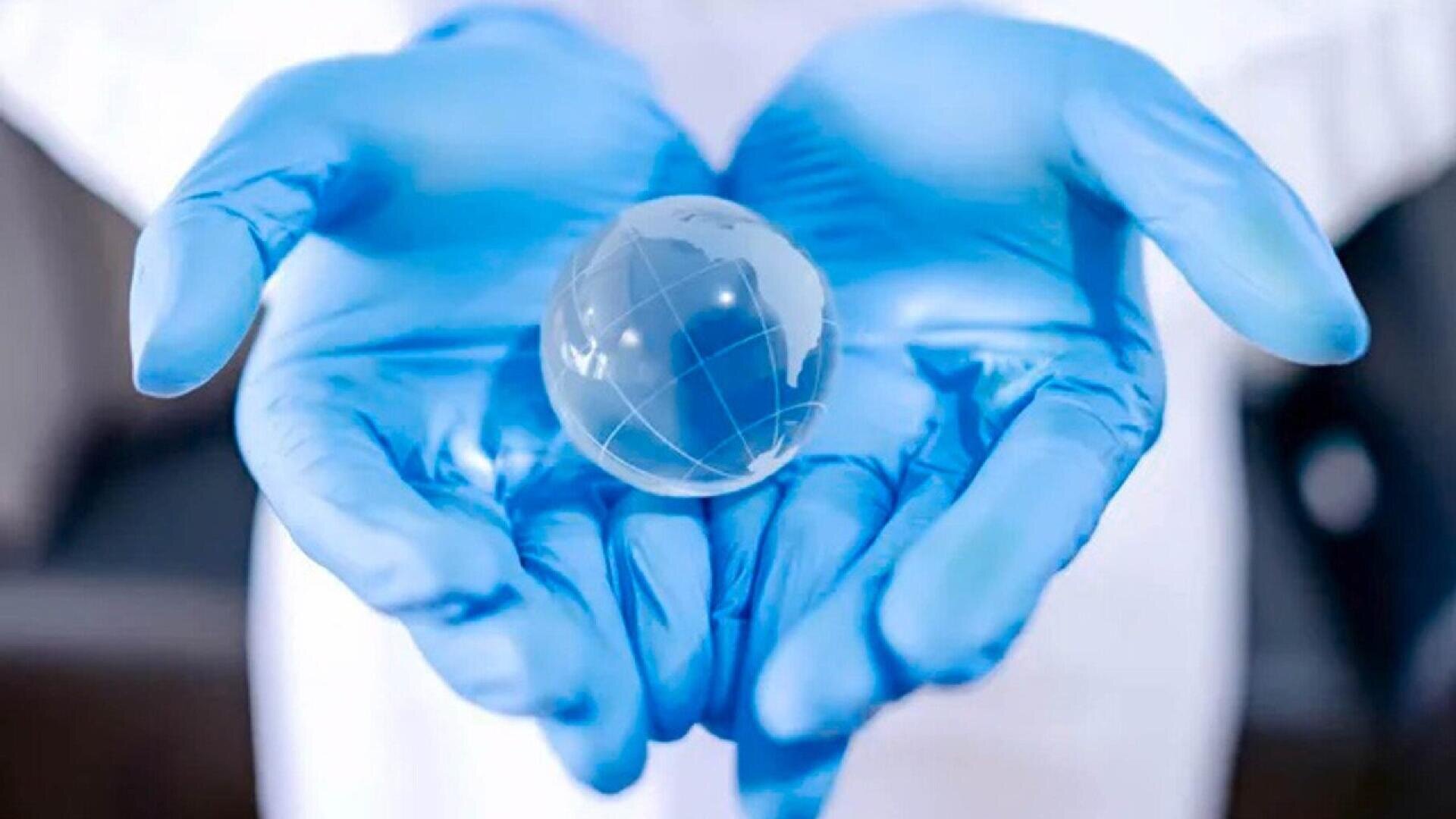Sustainability and medical technology – innovations and processes to fight climate change
The climate crisis is a big talking point not just in Germany and its neighbouring countries – all around the world, research, industry and society in general are working on making the world we live in more sustainable.
The key is to act in a way that preserves things for our grandchildren, so that future generations can live just as well as we do now. As a result, people are focusing on the issue in lots of different spheres – politics, production and trade, to name just three. The focus here is not only on the resources used for production. As described in the UN’s 17 Sustainable Development Goals, issues also include global supply chains and the digitalisation of processes. This is because ‘sustainability’ means shaping businesses in such a way that allows profits to be made in an environmentally and socially responsible manner – so that climate protection and social goals in general are promoted and supported. As part of this, sustainability is also an important part of our health, as physical and psychological burdens are reduced. Many industries are already in the process of making their products and processes sustainable and climate-friendly, but how much progress has the medical technology industry made in this regard? After all, this is a field where changes to materials used can have a direct impact on patient health. Is recycling even possible in the area of medical technology – i.e. the reuse of materials for applications where single-use products ensure patient safety and sterility? After all, it is hard to imagine a world without these disposable products. Are models for a circular economy or biological alternative materials a feasible approach to delivering sustainable methods? “In the field of medical technology, functionality absolutely takes priority in terms of the application. Nonetheless, there are many areas – including so-called single-use products – where sustainability is becoming an increasingly important issue. Here we are looking particularly at recycling techniques for the materials approved for use in medical technology applications. However, due to the regulatory requirements that apply, it is not usually possible to reuse materials in the same products again”, explains Udo Eckloff, subject specialist at the plastics company INNONET-Kunststoff.
It is clear: innovative ideas are needed in order to promote sustainability in the medical technology industry. New developments such as bioplastics made from corn starch or other renewable raw materials could have a significant impact on the amount of waste produced in the medical technology industry and make it much more sustainable – helping to make the industry much “greener” in the process. “Sustainability is a topic that affects the entire value creation chain, and it is becoming more important all the time. This is why, in the form of MedtecLIVE with T4M, we are attempting to offer a platform on which approaches and solutions for sustainability in medical technology can be presented and discussed”, explains Christopher Boss, Head MedtecLIVE with T4M and Executive Director Exhibitions of NürnbergMesse GmbH, emphasizing the importance of the topic.
There is vast potential for improvement in the field of medical technology. After all, the use of materials that are not particularly eco-friendly in complex manufacturing processes is commonplace here. “Particularly in the medical technology industry, this is a difficult topic – and one that has not been on our radar for long. For many manufacturers, sustainability does not seem to be relevant yet at all”, explains Sven Dasbach, Business Development Manager at Sanner GmbH. Some companies are, however, displaying a commitment and are actively engaging with the topic by attempting to develop and implement new ideas. Others in turn do not yet feel that the issue is relevant, or that it is important for the industry to do something about it. In addition, the requirements placed on medical technology products are very stringent and make it much harder to integrate sustainability in day-to-day working practices and manufacturing. This is something that Eckloff recognises: “In terms of the reuse of special materials, attempts are always being made to return sorted, single-material production components back into the process in order to achieve a degree of sustainability as a result. However, approaches relating to the certification and approval regulations that apply to medical technology need to be initiated and supported in particular by the appointed regulatory bodies and by the legislative powers. This first requires an in-depth analysis of whether it is possible to reuse materials – and if so, where they can be reused.”
Current status of sustainability efforts in the medical technology industry
Many different products and developments fall under the umbrella of the medical technology industry. It is a large field comprising many devices, processes and technologies that are firmly anchored in everyday medical activities. The range of products is vast, ranging in scale from disposable gloves and tubing to large CT devices. Many of these products include or are entirely made of non-biodegradable plastics. Katia Pacella, Circular Healthcare Projects Officer at Healthcare Without Harm (HCWH), explains how the provision of high-quality treatments in a sustainable manner that is environmentally and socially responsible is important not just for the sake of the climate and the environment. “A healthier planet directly contributes to the health of patients and the health of our communities.” The essential requirements in terms of guaranteeing sterility and safety for patients make it much harder to choose materials that are climate-friendly and biodegradable as well as promoting good health. The use of plastic products is a particular challenge for sustainable approaches to medical technology: “Sustainability is an important topic that has come increasingly to the fore in recent years, including in the field of polymer research. It is possible to achieve sustainability in different ways – by making energy savings during production, by optimising processes, during processing or transport, or through the choices made in terms of the materials used. However, depending on the work involved in the development process, this can mean higher costs”, says Dr. Christoph Herfurth, scientist at the Fraunhofer Institute for Applied Polymer Research IAP, in his appraisal of the current situation. “Sustainability starts with the raw materials, their origin and production, and continues with the emissions and the product design – where can we reduce the amount of materials used, where does it have to be a single-use product? But utilisation also plays a role, as does the supply chain – and looking to see whether we can avoid long supply chains”, explains Dasbach. Here, sustainability also covers safeguarding and optimising the healthcare sector: “We are talking about public health, safeguarding natural resources, defining safe environmental limits, and the circular economy in the production of materials. Human health can only be protected if the health of the planet is protected. Medical technology is absolutely essential for this”, summarizes Pacella.
When it comes to products that have already been approved, a more sustainable redesign plays a less important role. This is because changes to the product necessitate a re-certification, which takes up a lot of time and is expensive – and is not necessarily something the manufacturer will reap any rewards from. “If we are looking at major medical technology devices, such as a CT unit, then the numbers involved make it easier to consider efficiency and sustainability. In the field of disposable or single-use items, we are not currently seeing much demand, because there is a lack of pressure from the end consumer”, explains Dasbach, adding that the mindset of end consumers would definitely need to change before the market would start to adapt. As long as this commercial aspect is missing, Dasbach believes that there is no reason for manufacturers to change anything. Historically speaking, this is not unusual in the world of machine construction. Axel Bartmann, Head of Marketing & Corporate Communications at Manz AG, which also supplies to the medical technology industry and is exhibiting at MedtecLIVE 2022, has noticed how much the market has changed: “A lot of what is happening in relation to sustainability is being driven by companies’ own sense of responsibility. Nonetheless, this will also be also driven by the market if it is something that is important to customers.” For this reason, many large companies have already started to try and incorporate sustainability in their corporate values and to design internal structures to be more efficient and more climate-neutral. However, the topic is still in its infancy and the investments required to change existing products are too high, coupled with the fact that its commercial appeal is low, certainly at first glance.
Consequences of sustainability for medical technology and for the market
When it comes to sustainability, something needs to happen. Other industries are already several steps ahead on the issue. The consequences of doing nothing are already well established: global warming, microplastics everywhere and health implications for people. However, a restructuring of the market with increased focus on more sustainable products will also have consequences – for manufacturers and suppliers, but also for consumers. “Because the issue has been slow to raise its head in the world of medical technology, there are now already bottlenecks in the supply of bio-based plastics, as there are simply too few suppliers still at this point”, reports Dasbach. Herfurth explains how these materials can be used as alternatives depending on the particular requirements of an application: “Bio-based plastics can do a great deal and are already being used. Polylactic acid, for example, for packaging.”
Innovations and new developments take time. And to research, investigate and revise products generates a significant amount of costs for the manufacturer. Of course, this is not something that should come as a surprise. Niche materials and specialist staff to work on more efficient product designs, along with the re-certification processes that need to be performed when products are changed – these all take up a lot of resources. And the certification of sustainability also comes with complexity and added expense: “Whether for sustainability reports or measuring the impact of measures implemented to make companies more sustainable, this all costs time and money. But it is worthwhile because it is important to us”, summarises Bartmann from Manz AG. The company has built sustainability into its DNA – not satisfied with already being climate-neutral, it is always trying to find new ways to become even more efficient and even more frugal in the way it uses resources.
But the key arguments are protection and freedom from risk. “Bio-based plastics can deliver safety and reliability, but that is not always the case for everyone”, explains Dasbach. Accordingly, research is a very important area, and one that demands a great deal more investment.
Sustainability in medical technology – how is it supposed to work?
Many are asking whether and how sustainability should be implemented in this industry. One approach is modelled on the natural world, with circular models being a key approach to sustainability – only taking out as much as can be put back in again, and chemically breaking down the raw materials used, then recycling them and introducing them back into the manufacturing process. This is a way to save materials and produce less waste. It is an approach that is already being followed by a number of companies who build systems to break down and process special plastics so that they can then be used again in the manufacturing process. Pacella also sees circular models as an important step towards more sustainable business models: “In the medical sector there is an urgent need to move away from a linear production model. Non-toxic and reusable solutions are feasible and can reduce both the chemical footprint and the levels of waste produced, while at the same time offering improved solutions for patients and the planet.” Another important aspect for reducing the environmental footprint is the optimisation of manufacturing processes. Bartmann agrees: “Digitalisation also plays an important role here, particularly in production and in the procurement of goods. There are still significant levers at our disposal – and a lot of room for improvement.”
Another way is to look at the raw materials used. Particularly in medical technology, plastics are used in many areas. Examples include polyurethanes as hoses for intravenous catheters. However, the production of polyurethanes normally requires isocyanates, which are toxic and sensitising. They can trigger asthma and allergic reactions. “At Fraunhofer IAP, we have worked together with the Fraunhofer institutes ICT, IFAM and UMSICHT to develop a new synthesis process for polyurethanes, which allows us to do without the toxic isocyanates. This makes the production processes safer. The polyurethane produced in this way can then also be certified as biocompatible”, summarises Herfurth, who is coordinating the project. As a result, the number of harmful chemicals required for the production of these commonly used plastics has been reduced, and further processing also becomes safer. In the production of the plastic, CO2 is also used as a source of carbon instead of petroleum – offering a second element of sustainability.
Current efforts to achieve sustainability generally work primarily via a global approach. Here, small savings in terms of resources are made at lots of different points throughout the company. These all add up – ultimately making sustainability a very simple thing to achieve. “This no longer affects the product itself, but rather the production and all the other processes involved. The products are not the only lever we can use. For example, Sanner produces the majority of the energy it uses itself, and has been able to significantly reduce CO2 emissions at the Bensheim plant as a result”,. However, as a general rule processes are always cheapest if they are left just as they are. This is the reason why companies are reluctant to change their processes. Herfurth also adds: “One particularly promising approach to improving the sustainability of plastics is to use recycling. Here, plastic products are chemically broken down into their starting materials. These can then be used as recycled raw materials for the production of new materials. This makes plastic waste into a valuable recyclable material, and is the goal behind research work being conducted by the Fraunhofer team to find ways to recycle polyurethane waste. The raw materials gained in the process are converted using CO2 to new starting materials for isocyanate-free polyurethanes.” This needs greater focus, more information sharing, and new ideas. “In general, I believe that this is an important topic that is still not receiving enough attention in the field of medical technology. This is something we aim to change, and we plan to discuss it at MedtecLIVE with T4M with exhibitors and visitors. To this end, there will be dedicated sessions and a special tour on the topic as part of the programme”, summarises Boss.
About MedtecLIVE with T4M
The trade fair MedtecLIVE with T4M is the leading European event in the spring for the medical technology industry and takes place once a year, alternating between Stuttgart and Nuremberg. The event covers the entire value creation chain and brings together the most important medical technology regions in Germany in the process. Here, decision makers from distributors and OEMs meet face-to-face with key suppliers to the medical technology industry.


